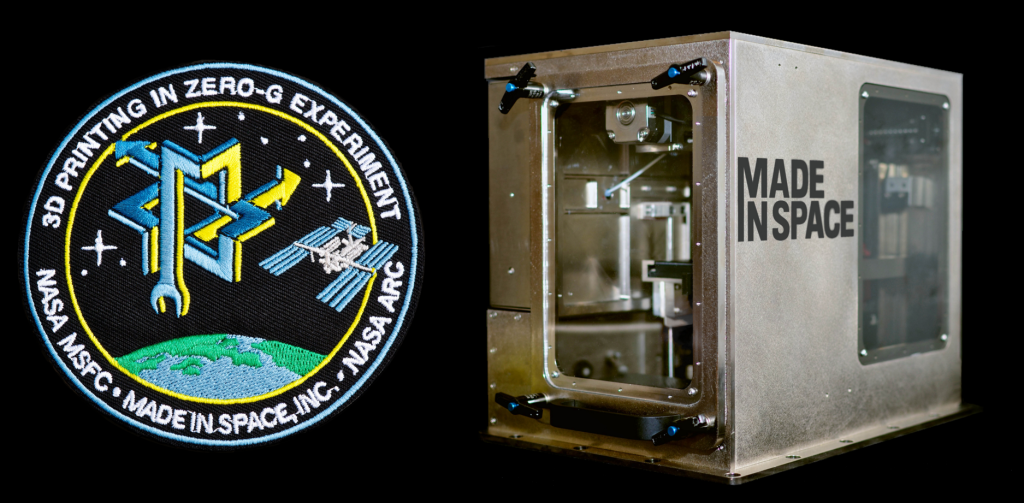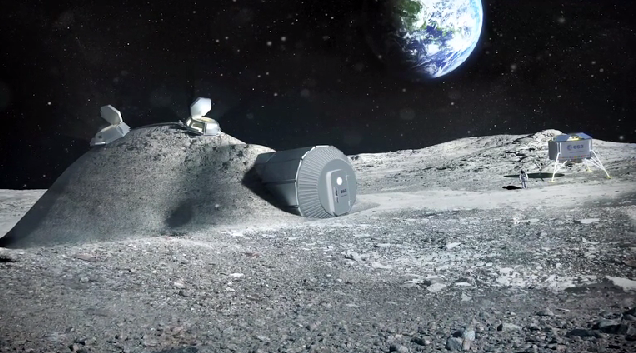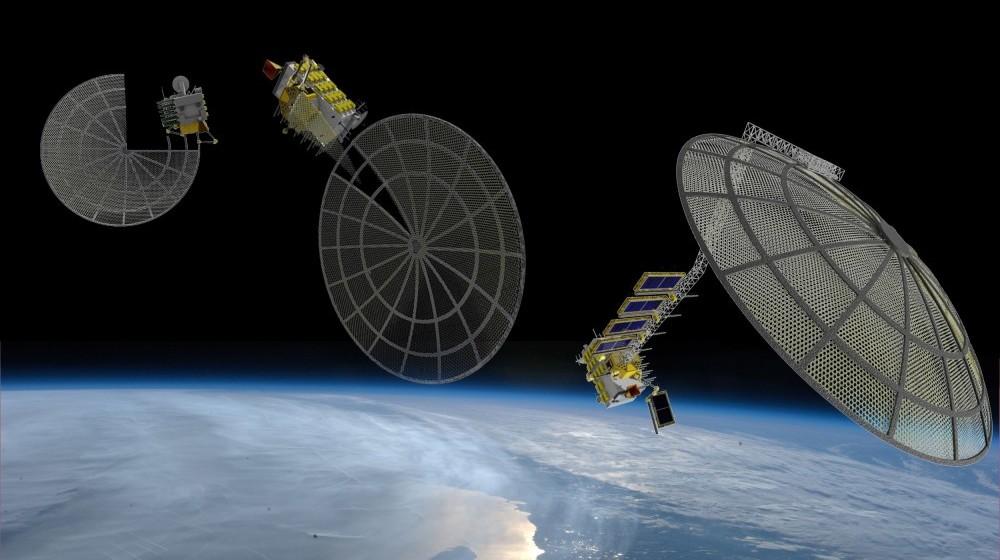The challenges for space travel are pretty simple to begin with, in concept. We must find a powerful method to shoot us there, up and out into orbit, and we need a safe, durable ride. But what about when you get there? Sure, you’ve brought along some of that cool astronaut food and fundamental provisions, but we all know traveling light is of the utmost importance. And because of that, self-sustainability has been one of the larger issues throughout our decades of experience in going to space; however, opportunities for self-sustainability just so happen to be one of the greatest benefits of 3D printing—and no one puts it better than NASA: technology is what drives exploration.
Certainly no strangers to the technology—entities like NASA began employing 3D printing far, far before most of us even knew it existed. Now, not only is 3D printing on Earth helping us to build everything from rocket engines to crucial supporting brackets, we’re sending the technology to space too. And it’s been a well-documented and well-followed ride with much of the world watching, from the first 3D printer arriving at the ISS from Made In Space—to that famous first wrench then being fabricated at the ISS by Commander Barry “Butch” Wilmore.
As the saga of 3D printing continues at the ISS, we step by step become that much closer to finding easier ways to subsist in space—and for longer periods of time—with the ultimate goal being colonization, whether on the Moon or Mars or beyond, for long periods of time. 3D printing a wrench was just the beginning.
 Tonight, another 3D printer heads to the ISS via NASA as the Cygnus spacecraft launches from Florida’s famous Cape Canaveral Air Force Station at 11:05 pm EST. 3D printing has been evolving heartily here on Earth, and now that shall be so at the ISS too, as Made In Space has updated their original design to allow printing of more components with more than 30 new materials so far—although only three new ones are heading to space tonight.
Tonight, another 3D printer heads to the ISS via NASA as the Cygnus spacecraft launches from Florida’s famous Cape Canaveral Air Force Station at 11:05 pm EST. 3D printing has been evolving heartily here on Earth, and now that shall be so at the ISS too, as Made In Space has updated their original design to allow printing of more components with more than 30 new materials so far—although only three new ones are heading to space tonight.
Housed in the updated Additive Manufacturing Facility for both NASA and the US National Laboratory to pay Made In Space to use, the new 3D printer will allow for expanded uses compared to the first model sent up in 2014. The AMF is a permanent facility on the ISS—expected to last as long as the station itself. So, if you were wondering about the long-term validity of 3D printing, you might take at look at what NASA has in mind, for perspective. The AMF offers great potential for sustainability in space.
It would seem that in traveling to space, we’ve learned both the benefits of traveling light, as well as sending provisions along later—and those provisions themselves seem to be evolving into more innovative systems that build upon themselves.“Space exploration is a lot like a camping trip—if something goes wrong or there’s an emergency, you’ve got to go home to fix it,” says Jason Dunn, Chief Technology Officer and co-founder of Made In Space. “3D printing will allow independence from Earth.”
With that idea in mind, feasibly one machine will create numerous objects that simply weren’t in existence previous to someone deciding to 3D print them in the AMF.“Raw materials pack down way tighter than built-out objects,” says Dunn.
“With an onboard printer, you can build things you could never deliver—like an antenna the length of a football field that supplies broadband Internet to the whole world,” says Spencer Pitman, Made In Space’s Head of Product Strategy.
Experimenting—and practicing—with microgravity is also a big challenge on earth. While there are methods in place here to experience with the loss of gravity and resulting sense of weightlessness that astronauts must train for, the optimum scenario would be actually practicing exercises like docking maneuvers in space itself.
“There’s currently no way to achieve extended microgravity on Earth,” says Dunn.
Parabolic flight and drop towers are currently used to simulate weightlessness, but more complex exploration of microgravity really should be done on site for the best results, obviously.
“The huge cost of getting projects to space is a bottleneck for most researchers,” Dunn says. “That’s where this printer comes in.”
A big price tag comes with it—but if you too are interested in testing out your hardware at the AMF, it can be done for a cost of $6,000-$30,000.
Ultimately, of course, many of these concepts and budding new practices extend to offering eventual full-time research facilities in other places besides the ISS. Colonization plans for the future offer outlines for actually using materials from somewhere like the moon or Mars, excavating and using building dirt or regolith, while 3D printers perform construction.
Archinaut is a new machine in development by Made In Space, in coordination with NASA, which will be able to 3D print large-scale structures, working in the vacuum of space, assisted by a robotic arm. To be installed on an external space station pod eventually, Archinaut should be able to make items like satellite reflectors, as well as being responsible for repairing machines and structures while in orbit.
These ‘little 3D printing machines’ may eventually be responsible for building entire, large communities far from Earth—and ones that will subsist on their own for nearly everything.
“Whether you’re on Mars or the ISS, you don’t want to have to wait for something to be sent to you,” says NASA spokesperson Tracy McMahon. “The more you’re able to build where you are, the better off you’ll be.”
It’s quite something to imagine astronauts, scientists, and civilians too, bustling around far from their home planet one day functioning quite well and living comfortably with 3 printed tools, homes—and even food. The future may indeed redefine the term ‘spaced out’ for some of us, as it becomes a very realistic and even attractive destination. What do you think the future of colonization in space entails? Discuss in the 3D Printers at the ISS forum over at 3DPB.com.
[Source: Wired]Subscribe to Our Email Newsletter
Stay up-to-date on all the latest news from the 3D printing industry and receive information and offers from third party vendors.
You May Also Like
Profiling a Construction 3D Printing Pioneer: US Army Corps of Engineers’ Megan Kreiger
The world of construction 3D printing is still so new that the true experts can probably be counted on two hands. Among them is Megan Kreiger, Portfolio Manager of Additive...
US Army Corps of Engineers Taps Lincoln Electric & Eaton for Largest 3D Printed US Civil Works Part
The Soo Locks sit on the US-Canadian border, enabling maritime travel between Lake Superior and Lake Huron, from which ships can reach the rest of the Great Lakes. Crafts carrying...
Construction 3D Printing CEO Reflects on Being Female in Construction
Natalie Wadley, CEO of ChangeMaker3D, could hear the words of her daughter sitting next to her resounding in her head. “Mum, MUM, you’ve won!” Wadley had just won the prestigious...
1Print to Commercialize 3D Printed Coastal Resilience Solutions
1Print, a company that specializes in deploying additive construction (AC) for infrastructure projects, has entered an agreement with the University of Miami (UM) to accelerate commercialization of the SEAHIVE shoreline...


































